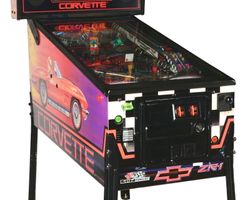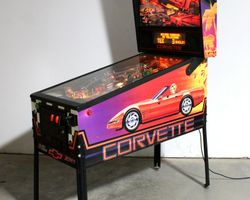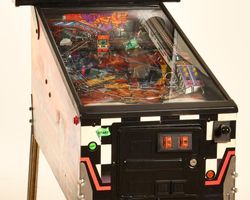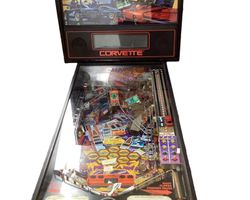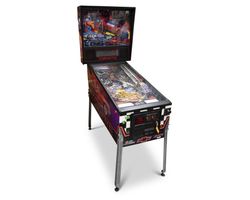Corvette
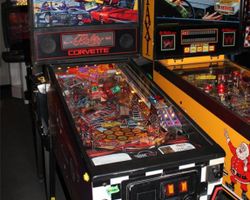
Average Prices: USD $1,400 to $3,000
Produced: August, 1994
Production Run: 5,001 units
Machine Type: Solid State Electronic
MPU: Williams WPC Security (WPC-S)
Players: 4
Concept by: George Gomez
Design by: George Gomez
Art by: Dan Hughes
Dots/Animation by: Scott Slomiany, Eugene Geer
Mechanics by: Thomas M. Kopera
Music by: Paul Heitsch
Sound by: Paul Heitsch
Software by: Tom Uban, Bill Grupp
The Bally "Corvette" pinball machine, released in August 1994, brought the high-octane world of America's sports car to the arcade. Manufactured by Bally Manufacturing Co., part of the Williams WPC Security (WPC-S) generation, this machine was designed to immerse players in the thrill of driving and collecting the iconic Chevrolet Corvette. A total of 5,001 units were produced, making it a moderately common yet highly sought-after title among enthusiasts of both pinball and automotive culture.
The machine's creation involved a skilled team. George Gomez, whose concept shaped the game, made his debut as a playfield designer with "Corvette." His vision was brought to life by artist Dan Hughes, while the mechanical engineering was handled by Tom Kopera, marking his first contribution to a Williams pinball machine. The intricate software that drove the game's mechanics and modes was developed by Bill Grupp and Tom Uban, with Paul Heitsch responsible for the distinctive music and sound design. Eugene Geer and Scott Slomiany crafted the animations that played out on the Dot Matrix Display.
During its development, "Corvette" underwent several design iterations. Initially conceived as a widebody machine, the design eventually reverted to a standard cabinet size before any widebody prototypes were built. Early prototypes also featured a bank of three drop targets on the left side of the playfield, which were later replaced by stand-up targets to manage production costs. Another ambitious feature, a physical 4-speed shifter intended for the dragstrip mode, was also present on some prototypes but ultimately removed from the production model for similar reasons, though the underlying code for these elements remains within the game's software.
An interesting footnote in its history involves the National Corvette Museum in Bowling Green, Kentucky. Very early production units, distinct from prototypes, were made for the museum. These "NCM" games included a special welcome message in their code. George Gomez himself was involved in setting up displays at the museum, showcasing design drawings, prototype playfields, and other development materials. During the grand opening celebration, these machines were operated around the clock for charity, with Gomez and other team members present to promote the game. One unique detail related to licensing: sample games featured the "Delco" name on the red Corvette on the translite, a logo later removed from the main production run due to licensing considerations. The character on the playfield, who also provides French speech, was modeled after George Gomez's girlfriend at the time, Lori Hanson, an American Airlines flight attendant.
Signature Features and Design
"Corvette" distinguishes itself through a suite of interactive features that deeply integrate the automotive theme into the gameplay. The machine boasts a multi-leveled playfield, enhancing visual depth and shot variety. A centerpiece of the playfield is the LT-5 engine toy, a large, plastic replica of the legendary engine that physically shakes, simulating the power and rumble of a high-performance engine as balls are locked within its mechanism. This tactile feedback heightens the sense of immersion, particularly during engine multiball modes.
Another standout element is the Matchbox car racetrack located on the right side of the playfield. This straight track features two miniature Corvette cars that physically advance based on player actions during the racing mode. This unique interaction allows players to directly compete against the machine in a visually engaging manner, making the "Race Today" mode a memorable experience.
The custom speech, often featuring distinct engine sounds and phrases, further enhances the thematic integration. The Dot Matrix Display, standard for games of its generation, displays animations and scores, including a particularly engaging one in the backbox where collecting all nine Corvette cars and completing a puzzle reveals the future C6 Vette in a helmet visor. These details, from the shaking engine to the racing cars and specialized display animations, collectively define "Corvette"'s identity, elevating it beyond a typical pinball experience into a dynamic homage to the celebrated American car.
Playfield and Mechanics
The "Corvette" playfield is a carefully crafted arena designed for speed and precision, offering a layout that encourages fast-paced gameplay. It features three flippers, with two at the bottom and an upper right flipper that enables crucial shots to the upper playfield. Three ramps define the primary shot paths: the prominent Route 66 ramp, which is central to initiating game modes, and a Side Ramp that becomes vital for increasing multiball jackpots. The playfield also incorporates three pop bumpers, contributing to chaotic ball movement and score accumulation.
Major shots include the LT1 rollover lanes at the top, which serve as the initial skill shot target and are essential for increasing the bonus multiplier. The Side Loop and Side Ramp offer flowing shot opportunities, while the Raucous Target provides a high-scoring objective. The Pit In sinkhole lights the "Challenge" mode, a rapid-fire interaction that tests a player's flipper speed. A bank of three stand-up targets activates "Turbo Boost," which subsequently lights the spinner for boosted points. The left outlane is equipped with a kickback, a defensive feature, though some players note it can sometimes lead to an immediate ball drain due to the playfield's geometry.
The playfield's artwork, handled by Dan Hughes, complements the theme with vibrant depictions of various Corvette models, racing scenarios, and automotive elements. While some critiques mention the art as occasionally "cartoonish," it generally aligns with the playful, high-energy theme. Lighting is strategically placed to guide players to active shots and emphasize mode progression. The overall aesthetic, from the cabinet art to the backglass, which depicts a large red Corvette with a driver in a helmet, aims to capture the essence of performance and car culture, immersing players in a visually stimulating racing environment. The layout's design philosophy focuses on maintaining ball flow and providing varied shot opportunities that are both challenging and rewarding, contributing to an experience that feels like a true test drive.
Gameplay Dynamics
"Corvette" provides a multifaceted gameplay experience, driven by its blend of scoring opportunities, interactive modes, and a core objective centered around collecting iconic vehicles. Gameplay begins with a manual plunger, initiating a skill shot that involves navigating the ball through the LT1 rollover lanes for immediate points, with a "Super Skill Shot" option offering even greater rewards.
The primary objective is to collect nine different Corvette cars, visually represented in a honeycomb pattern on the backbox display. These cars are awarded through various means: by winning "Route 66" mode awards, successfully completing the "Challenge" mode, locking balls during specific multiball phases, and winning the drag race video mode. Collecting all nine cars unlocks the final puzzle wizard mode, a four-ball frenzy.
"Corvette" features multiple multiball modes, offering distinct objectives and scoring potential. The core "LT-5 Engine Lock" mode is a three-ball multiball initiated by locking balls in the shaking engine toy, leading into "Rev Mode" for intensified scoring. Jackpots within this mode are maximized by precise shots to the Side Ramp. Other multiball scenarios include the two-ball "Catch Me," "Race Today," and "Pit Stop" modes, each providing unique challenges and scoring avenues.
The "Route 66" ramp serves as the gateway to various single-ball modes, offering diverse gameplay scenarios. These modes range from "Catch Me," a timed shot-based challenge, to "Car Awarded," which directly contributes to the car collection. Other awards include "Pit In" (a hurry-up bonus), "Quadra Jets" (boosting pop bumper values), "Bonus X" (increasing the end-of-ball multiplier), and direct point awards, specials, or extra balls.
"Corvette" also incorporates several interactive video modes. The "Race Today" mode places players in a drag race, using the left flipper for gas and the right flipper for shifting gears, demanding rhythmic input for success. Another video mode challenges players to rapidly press the flippers to speed up a pit crew during a timed repair, while a "Rev Bonus" mode requires quick flipper presses to build up a bonus before engine multiball. The "Challenge" mode, lit at the Pit In sinkhole after completing "Speed Parts" targets, pits a red car against the player's blue car, controlled by flipper inputs. Successful completion awards points and a celebratory animation. The game’s scoring system is further enhanced by "Spark Plugs" collected from lit shots, "Track Combos" for consecutive shot sequences, and a detailed end-of-ball bonus that tallies collected cars, Turbo Boost points, Raucous points, and combos. High scores are tracked through specialized categories like "World Speed Record" for orbit shots and "Cornering Champ" for small loop shots, encouraging varied play strategies.
Reception and Legacy
Upon its release and in the years since, the "Corvette" pinball machine has generally been well-received within the pinball community, often described as an underrated title. Its strengths frequently cited include its smooth and fast-paced gameplay, with many players describing the experience as "flowy" and emphasizing a sense of speed. The integration of the Corvette theme is widely praised; the artwork, including the cabinet and backglass, is considered visually appealing and effectively conveys the essence of the automotive brand. The inclusion of the interactive LT-5 engine toy and the functional dragstrip feature, where players can race miniature cars, are consistently highlighted as standout and engaging elements that make the machine distinctive. The sound and music, while occasionally noted for being repetitive by some, are generally regarded as fitting for the theme, enhancing the high-energy atmosphere. The game's variety of shots, modes, and objectives offers substantial replay value and challenge, appealing to both experienced players and those new to pinball. Many find its design well-executed, featuring challenging ramps, loops, and shots that keep players engaged. It is often recommended as an accessible and fun machine for casual play and entertaining guests.
However, "Corvette" is not without its criticisms. Some players find the rules and modes to be somewhat shallow or disjointed, lacking the deep strategic layers present in other machines of its era. Mechanical quirks, such as the left outlane kickback sometimes leading to immediate ball drains, or ramps occasionally rejecting shots, are also mentioned. While the art style is generally appreciated, a segment of players describe it as "uninspired" or "cartoonish," and the backglass art is sometimes perceived as "plain" or "busy."
Despite these minor points, the overall sentiment towards "Corvette" remains very positive. Many collectors and enthusiasts consider it a must-have for car aficionados and a challenging yet enjoyable experience for any pinball player. Its legacy is tied to its innovative interactive toys and its role in the careers of its designers. As George Gomez's first playfield design, it laid the groundwork for his extensive and influential career in pinball. Similarly, Tom Kopera's work on the machine marked the beginning of his contributions to Williams pinball, leading to collaborations with Gomez on future titles, including "Cactus Canyon." "Corvette" stands as a testament to thematic immersion in pinball, proving that a strong license, combined with inventive mechanics, can create a memorable and enduring machine.
Sponsored Links
 Ebay Listings
Ebay Listings
 Auction Results
Auction Results
| Cost | Location | Date |
|---|---|---|
| USD $4,000 |  Kansas, United States Kansas, United States |
16 November, 2025 |
| EUR €6,300 |  Nordrhein-Westfalen, Germany Nordrhein-Westfalen, Germany |
05 December, 2024 |
| USD $3,800 |  Ohio, United States Ohio, United States |
27 April, 2024 |
| USD $7,999 |  California, United States California, United States |
10 March, 2024 |
| USD $7,995 |  Ohio, United States Ohio, United States |
02 December, 2023 |
| USD $3,250 |  Maryland, United States Maryland, United States |
25 May, 2023 |
| USD $5,500 |  Nevada, United States Nevada, United States |
11 March, 2023 |
| USD $7,000 |  Florida, United States Florida, United States |
03 January, 2023 |
| GBP £2,625 |  United Kingdom United Kingdom |
11 December, 2022 |
| USD $5,000 |  Ohio, United States Ohio, United States |
28 October, 2022 |


Private Policy · Search Website · Contact Us
As an eBay Partner, we may earn a commission from qualifying purchases made through links on this site, at no additional cost to you.
All trademarks and copyrighted materials remain property of their respective owners. All other content copyright 2007 - 2025 Pinpedia.

